V.
Threaditional
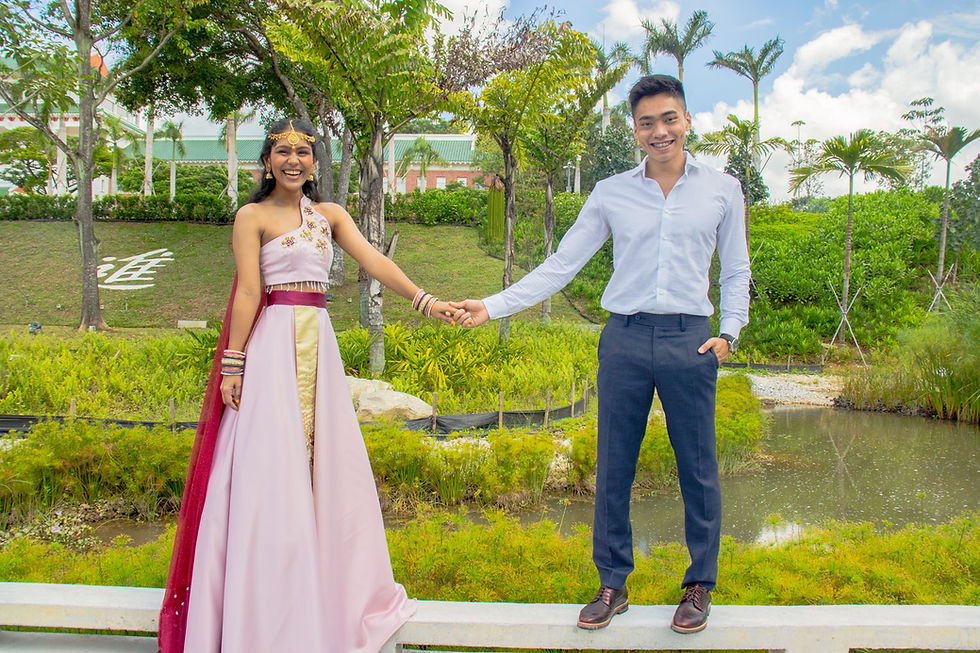
NTU, School of Art, Design & Media.
Graduate of Year 2020.
Final year project.
Award winning piece
significance & goals

The significant rise in the number of interracial marriages since 20 years ago, has sparked the idea of fusion, signifying the union of the couple. It takes a huge sum of money to prepare for the wedding ceremony and reception. In particular, a wedding dress that is usually worn only once in a lifetime can easily cost up to tens of thousands of dollars in the market today. Moreover, interracially married couples require multiple gowns — one for each of their customs, and at least another for their reception.
If interracial fusion gowns are available for these ceremonies, the entire cost of the wedding will decrease drastically. This Final Year Project attempts to create three sets of fusion wedding gowns, Motifs from different traditional wedding gowns are studied and reinterpreted for contemporary uses. These are then integrated into a wedding gown form that reflects the union of interracial couples.
This project focuses on the 4 major races in Singapore.
INTERRACIAL WEDDING GOWNS
"reflects the union of different cultures"

Hence, this study aims to explore the origins and symbolism of motifs from traditional wedding gowns, and how can they be integrated into fusion gowns and make the gown meaningful to the couple. Motifs are significant, especially to the Chinese, Malay, and Indian textiles studies as they are symbolic and used in everyday livelihood, not only on their clothes but hardware as well. The term “fusion” refers to the seamless combination of multiculturalism in a single dress. This project will contribute to the fashion history and heritage of Singapore.
colours
Colours play a significant role in Asian context
Traditional cultures from different countries have influenced the design of traditional costumes. The colours used are also of strong significance to their history. Colours have positive and negative connotations in both the Eastern and the Western worlds, which may sometimes be the same or drastically different. Colours have positive and negative connotations in both the Eastern and the Western worlds, which may sometimes be the same or drastically different. They can be an adjective or metaphor, where meaning can quickly disappear during translation from Chinese to English and vice versa. Colours play a significant role in the Asian context, from the clothes worn on special occasions to decorations of the surroundings. Chinese are superstitious with regard to colours. It is considered inauspicious, even disrespectful if a wrong colour was chosen for any important event. Thus, to avoid such a situation, the colours used in the fusion gown needs to be carefully considered.
Colours such as Pink, Red and Gold were considered colours of Royals and especially used in weddings. Many beads and embellishments were added to dazzle up the dress.
Whereas in the British culture, Cox (2002) suggested that white was the colour for wedding gowns as it represented the virginity of the bride. This is the reason why a bride who is marrying for the second or third times would not put on a white dress. In addition, colours played a significant role in different eras; for instance, the Romans had pale green gowns in the sixteenth and seventeenth centuries as it represented the idea of “fertility”. The white gown trend only began in the nineteenth century and remains until today. In the past, it also signified wealth, status, and purity as it was costly to dress one’s daughter in a full white gown. Thus, only the wealthiest could afford to marry their daughter in their dream dress

motifs
Innovative and versatile motifs
Eight themes that are most commonly seen in weddings gowns are selected, namely Beauty, Fertility, Abundance, Purity, Auspicious, Harmony, Happiness, and Virtue. Motifs from each race that signify each of these themes will be chosen and matched with motifs from another race. The integration of the traditional motifs has produced 12 fusion motifs. These motifs can be applied on any surface, for any purpose, not just for the wedding gown. Symbolisms of the motifs are carefully considered and paired together to form the final motifs.









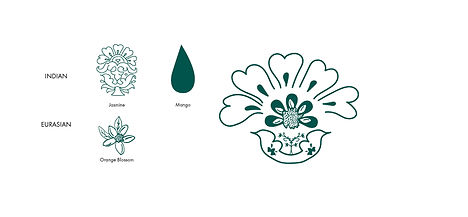


Final motifs



The Chinese Indian motif representing fertility is inspired by osmanthus flower, peacock and mango. The teardrop shape of the motif is “Kalga”, also known as mango, is an auspicious symbol for fertility, enclosing the peacock feathers. The bottom half of the motif is osmanthus petals and leaves.
the Malay Eurasian motif representing virtue is a gentle and dainty snowflake. It is inspired by bees, butterflies, and lily. The wings of a butterfly have the texture of a bee's wings, that radial outwards, surrounded by the anther of a lily flower, and the antenna of a butterfly.
“The natural world is built upon common motifs and patterns. Recognizing patterns in nature creates a map for locating yourself in change, and anticipation what is yet to come.”
― Sharon Weil, ChangeAbility: How Artists, Activists, and Awakeners Navigate Change
the Chinese Eurasian motif representing love is inspired by the dragon, phoenix, butterfly and rose. Dragon and phoenix are iconic symbols in the Chinese culture, which signifies the love between the “perfect couple”. Butterflies illustrate the freedom to love and rose is the symbol of romance. However, since dragon and phoenix on the Chinese Kwa are not popular amongst people who are more religious, it is not advisable to include it onto the dress. Hence, instead of having the entire duo sewn onto the dress, parts of them are added into the motif. The trails on the four sides are the tails of a phoenix, and the dragon scales are in the intersection of the butterfly wings. With this, the essence and blessings of the Chinese culture are added on to the dress, but not assertive.
sketches
Chinese -Indian



Chinese - Eurasian



Malay- Eurasian

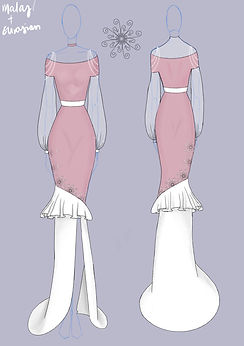

Final designs
Chinese-Indian
Fertility

Malay-Eurasian
Virtue

Chinese-Eurasian
Love
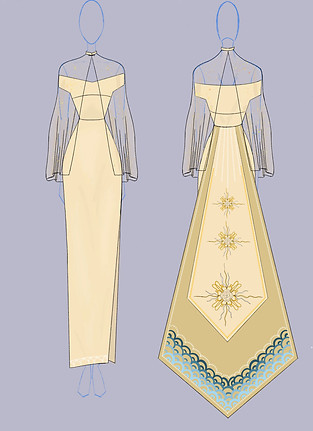
final outcome




Chinese-Indian
Fertility
Hand embroidery

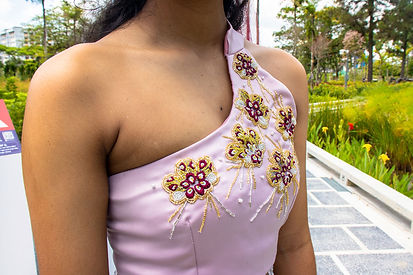

These are the final embroidery on the Chinese Indian dress. The embroidery was hand sewn onto the garment. Below shows a golden panel with motifs and gold beads. This panel is an additional accessory taken from the Chinese kwa as it represents fertility.
This is the Chinese Indian Gown, fertility after revision. It is pink as it is a colour often donned by both the Chinese and Indian communities. Instead of the conventional dress, a pair of pants is adopted as inspired by Indian Punjabi. The outer skirt is removable, thus the bride is able to choose when she wishes to put it on or remove it during different occasions.
This gown was an award-winning piece in a local fashion design competition.

Malay - Eurasian
Virtue


This is the Malay Eurasian gown, Virtue.
This dress was suppose to be modelled by a Malay friend, however due to Covid-19 circuit breaker, I had to model the dress myself and take photos around my neighbourhood.
The sleeves are made of mesh and not entirely exposed. After interviewing the interracially married brides, some of them, in fact, is not as conservative, but able to accept showing some skin even though they were Muslims. One Muslim lady even wore an off-shoulder dress for her wedding. Nonetheless, it is still preferred to not be over revealing. Hence the gold piece on the outside which is inspired by the Baju Kurung top piece can be put on to provide more coverage. Furthermore, mermaid dresses are according to interviews, the most popular dress design in recent years hence is adopted into the design of the dress
Hand embroidery



The motif was formed using gold threads and white beads. Since this dress represents virtue, it should look gentle and dainty rather than extravagant and loud. Using the white beads that gives off blue and pink sheen under the light, supports that idea, making the dress soft and sweet. The embroidery on the Malay Eurasian dress is arranged in a way such that it embraces the figure of the wearer, making her curves more evident, enhancing the idea of a mermaid gown.

Chinese - Eurasian
Love

The motif was formed using gold threads and white beads. Since this dress represents virtue, it should look gentle The Chinese Eurasian gown, love, is chosen to be cream and gold in colour instead of bright red which is seen on Traditional Chinese Kwa. This is because according to the interview with the wedding gown boutique, younger Singaporean Chinese are not so into Vibrant red, but prefer something more subtle. Hence, using gold colour would be suitable as it usually donned by royalty, just like how the bride should feel like the queen on her special day. The removable Mandarin collar and sleeves are inspired by the Chinese Kwa. The dress also has slits on each side, inspired by the Chinese Cheongsam. These long panels symbolise fertility, which is a value usually upheld by very traditional Chinese families. dainty rather than extravagant and loud. Using the white beads that gives off blue and pink sheen under the light, supports that idea, making the dress soft and sweet. The embroidery on the Malay Eurasian dress is arranged in a way such that it embraces the figure of the wearer, making her curves more evident, enhancing the idea of a mermaid gown.


Hand embroidery


Head piece is an essential element in the Chinese kwa. However, the original head piece is like a hat that covers the whole head. Instead of making a head piece that might overpower the dress, a smaller pin is made, so be placed at the back of the hairdo. It resembles the motif and the trails are made of beads and wire, bent in the way the motif is drawn. Dangling bead on the side is also taken from the original head piece.
The embroidery on the train was done directly on the fabric, all using gold threads and beads of various colours and sizes. The bottom train shows a blue gradient motif with a gold outline. It symbolises the cloud, which also means “to be on cloud 9”, meaning happiness. This dress represents love and happiness is important, hence it is added into the dress. Furthermore, the dress is predominantly cream and gold, thus adding blue to it gives the dress some life.


* Photos were taken at the beginning of Singapore's Circuit Breaker, hence I was unable to find a model for my dress. As a result, I had to model the dress myself to abide by the rules of the circuit breaker.
In the making of Threaditional
Let me present to you... Threaditional
Thank you to Professor Jesvin Yeo, Galina Mihaleva and Desmond Koh for guiding me through this FYP journey. This is a project close to my heart and still fervently exploring it, it was only done well because of your undying support.